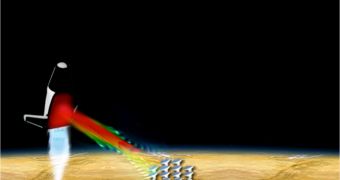For years, aeronautics experts have been trying to find alternatives to the standard space launch – a rocket that is powered by burning chemical fuel. An alternative proposition that scientists are seriously considering now calls for the use of lasers or microwaves beam to launch spacecraft.
Under the new approach, called beamed thermal propulsion (BTP) narrowly-focused beams of light or microwaves are shone on a spacecraft, providing it with the energy it needs to reach escape velocity and make its way into low-Earth orbit (LEO).
At this point, a space launch is achieved when the bottom end of a rocket is set on fire. The ensuing controlled burn makes the rocket lift, hover for a bit above its take-off site, and then lift off.
But this approach has a large number of drawbacks. For starters, it is very expensive, and also somewhat unreliable. The highly-refined chemicals used in rocket fuel are also very polluting, and numerous rocket launches can punch a hole in the ozone layer.
The new vision would eliminate all of these problems. The costs of focusing a microwave beam onto a spacecraft are a lot smaller than those associated with building and launching a rocket.
An added advantage would be that single-stage rockets would be sufficient for more applications, eliminating the need for expensive, 3- to 5-stage delivery systems. A consequence of this would be that payload spaces would increase 2 to 5 times over current levels.
This would in turn translate into significantly diminished price tags attached to space launches, and therefore more innovation, and more interest into the field. All that is needed for that to happen is for the proposed alternative launch system to work.
By March 2011, the American space agency is scheduled to conclude a feasibility test of the new beamed energy propulsion systems. If experts establish that its doable, then funds will be alloted to create a prototype spacecraft and launch facility.
“The basic idea is to build rockets that leave their energy source on the ground. You transmit the energy from the ground to the vehicle,” says the President of Kare Technical Consulting, Jordin Kare.
He and his company are credited with having developed the laser thermal launch system concept some ten years ago. Its basic operating principle is that microwaves or laser beams are focused on a heat exchanger-like device aboard the rocket.
This instrument would then transfer the energy it receives to liquid propellant such as hydrogen, which will thus be converted into a hot gas that will be propelled out of the nozzles, providing thrust.
“People can launch small satellites for education, science experiments, engineering tests, etc. whenever they want, instead of having to wait for a chance to share a ride with a large satellite,” Kare concludes, quoted by Space.

 14 DAY TRIAL //
14 DAY TRIAL //